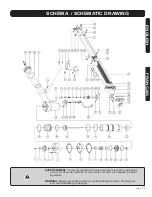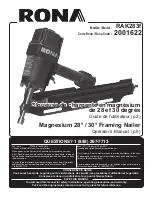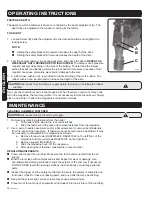
IMPORTANTES DIRECTIVES DE SÉCURITÉ
14
RAK283b
ENGLISH
!
CLEAN AND INSPECT DAILY
CAUTION:
Disconnect tool from air supply before cleaning and inspection. Correct all
problems before putting the tool back in service.
Wipe tool clean and inspect for wear or damage. Use non-flamable cleaning
solutions to wipe exterior of tool only if necessary. Do not soak tool with cleaning
solutions. Such solutions can damage internal parts.
Inspect trigger and safety mechanism to assure system is complete and functional:
no loose or missing parts, no binding or sticking parts.
Keep all screws tight. Loose screws can cause personal injury or damage the tool.
If the tool is used without an in-line oiler, place 2 drops of air tool oil into the air inlet
of the tool at the beginning of each workday and after about 1 hour of continuous
use. Frequent but not excessive lubrication is required for best performance. Oil
added through the airline connection will lubricate all internal parts. Use only
air tool oil. Do not use oil with detergents or other additives. These can cause
damage through accelerated wear to the seals in the tool.
Use a small amount of oil on all exterior moving parts and pivots.
Dirt and water in the air supply are major causes of pneumatic tool wear. See the
section on SETUP: AIR SOURCE above for more information.
Keep tools clean for better and safer performance. Use non-flammable cleaning
solutions sparingly and only if necessary. Do not soak parts in the solutions.
CAUTION:
Such solutions may damage O-rings and other parts.
MAINTENANCE
WARNING:
Stop using the tool immediately if any of the following problems occur.
Serious personal injury may result. Any repairs or replacements must be done by
qualified personnel or by an authorized service centre only.
CAUTION:
Disconnect the tool from air supply before performing any service procedure.
When inserting new or re-installing O-rings, make sure they are clean and lubricated
with an O-ring lubricant.
TROUBLESHOOTING
!
!
PROBLEM
CAUSE
SOLUTION
Air leak at trigger area
1. O-ring in trigger valve damaged or cracked
1. Check & replace O-ring
2. Trigger valve head damaged
2. Check & replace trigger valve head
3. Trigger valve stem, seal or O-ring damaged
3. Check & replace trigger valve stem, seal, or
O-ring
Air leak between body and front plate
1. Piston O-ring or bumper damaged
1. Check & replace O-ring or bumper
Air leak between body and cylinder cap 1. Screw loose
1. Tighten screws
2. Damaged seal
2. Check & replace seal
Tool driving fasteners too deeply
1. Worn bumper
1. Replace bumper
2. Air pressure too high
2. Adjust air pressure at regulator
Tool runs slowly or has power loss
1. Insufficient lubrication
1. Add oil as instructed
2. Insufficient air supply
2. Check air supply
3. Broken spring in cylinder cap is blocked
3. Replace spring
4. Exhaust port in cylinder cap is blocked
4. Replace damaged internal parts





































